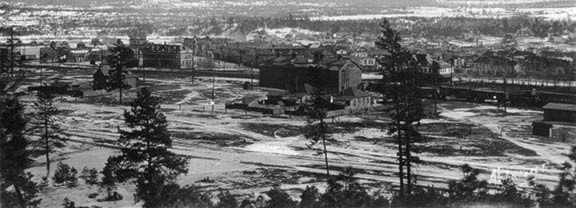Jim Cameron
Ice. It is merely stating the obvious to say that this time of year ice is everywhere. That is as it should be.
On the other hand, in the other part of the year, in the other part of the year in the earlier days of the city, in the hot, dry part of the year, ice was a necessity in ensuring a satisfactory quality of life. And therein lies the rub. When you don't need ice you have plenty of it and when you do need it ... it's gone.
As to its importance, here's a question: Name one of the largest buildings in Cranbrook; let's say from the early 1900s to the 1970s. If you guessed the CPR icehouse you are correct.
The CPR's original icehouse was large. The replacement constructed in 1909 was larger and the replacement's replacement, built just to the west of the CPR station in 1920, was very large indeed, one of the largest in the interior. The timber structure stood approximately 30 feet high by 45 feet wide by 140 feet long. It was big because it had to hold 3,000 tons (6,000,000 pounds) of ice. To draw a page from Cranbrook history that is the equivalent of 600 elephants, more or less, all standing on each other's shoulders in the CPR yard icehouse, an icehouse meant to store ice from Moyie Lake, or McKenzie Pond (now McKenzie Puddle) or the old city reservoir (Idlewild) or Crow's Nest and other lakes in Alberta.
That was just the ice for the CPR mind you; ice for the galleys and the refrigerated fruit and vegetable cars and later the air-conditioned passenger cars.
Cranbrook needed much more ice than that. The hotels, pubs, meat markets and grocery stores all had their own icehouses. Icemen delivered daily to homes if required. Pure, clear blocks of ice in any quantity suitable for iceboxes (the precursor of refrigerators).
Obtaining the ice in the first place took a great deal of manpower and energy, often 20–30 men working weeks at a time beginning in January or February. Teams of horses pulled wooden scrapers over the frozen lake to clear off the snow. A "shine sled" made sure the surface was clear of any of the horse droppings left behind, sometimes swiping the surface with formaldehyde for good measure. Holes were then drilled through the ice at intervals to indicate where cuts should be made and a guide-plank employed allowing a saw to make a shallow cut along the entire field. Horse drawn cutters deepened the cut and handsaws finished the job.
The chunks of ice were then floated to the loading area, placed on wagons (or trucks or boxcars) and hauled to the icehouse. Uniform blocks made storage much easier but the ice could easily vary from a thickness of 10–35 inches. That is, unless you were the Cranbrook Butter Co. who, in 1917, layered water in their icehouse to form one giant ice cube. Not so large an ice cube, however, as the one created in October, 1934, when the big CPR ice house burned to the ground. It was one-third full at the time (about 200 elephants, though none were hurt) and the result was a very large, autumnal iceberg which took a number of men a number of days to remove in order to rebuild a similar icehouse on the same spot (which was still in place in the 1970s).
In its ice heyday Cranbrook was capable of using 10,000 tons during the year, as estimated by W.E. "Pop" Worden, owner of the Cartage and Transfer Co., who for decades ruled as the Chief Ice Harvester of Cranbrook, along with sand, gravel, furniture and pianos. Pianos are mentioned because, in 1938, if you wanted to buy a Frigidaire refrigerator to replace the old icebox, you went to the Cranbrook Music Store to purchase it, but that's neither here nor there, nor anywhere now.
Ice had its dangers of course. In 1932 Charlie Barnhardt was pretty badly injured when a block of ice slipped (not surprisingly) and struck him a solid blow on the noggin. He recovered nicely. Not so for Herbert George who, in January, 1927, slipped (not surprisingly) on an icy slope near the King Street railway crossing and cracked his head on the ice. Somewhat shaken he managed to walk home, attend a New Year's Dance and visit the Little Davenport Café where he collapsed, dying a few hours later from a brain hemorrhage.
Surprisingly, there are few other recorded injuries directly attributed to ice, except of course for hundreds of accidents due to icy road conditions and, well, the Titanic of course.
Ice can be fun, as any skater knows. In the early days Elizabeth Lake was the place to be on a winter's afternoon. Late November would see upwards of 400 people gliding across the pond. The first local ice carnival occurred at the Arena Rink in Rotary Park in January, 1910. It was a masquerade featuring the winning costumes "Joan of Arc" (ironically, considering her death), "Grandma", "The Gold Dust Twins" and "Zulu" (perhaps not the wisest winter costume). This, in turn, led to a plethora of Ice Carnivals, Festivals, Galas, Follies and Capades, not to mention our own Kootenay Ice hockey team.
Ice can sometimes be scientific, as in the 1907 local ad for Maycock's patent refrigerator which "prevented sweating and dropping in the provision box" because no-one wants that, that's for sure.
It can also be cryptic, vis-a-vis the 1923 classified ad from a local real estate firm stating "For Sale: Large-sized refrigerator suitable for small town."
As it is, this whole subject is becoming a little slippery so perhaps it's best to just put it on ice.
janusthenandnow@shaw.ca
